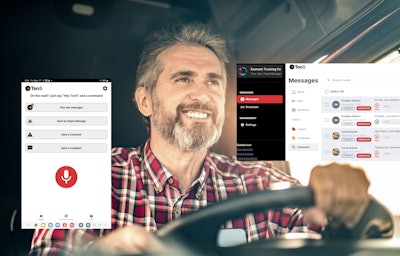
A new technology company has entered the trucking scene with a communication tool that aims to improve driver safety and retention. Ten5 Inc. has joined the market with the launch of its hands-free voice assistant that uses proprietary voice technology and artificial intelligence to make it easier for drivers to communicate safely with fleet back offices while on the road.
Ten5 CEO Drew Ryder said most fleet communications today are text based or via phone call, both of which can be ineffective, inefficient and distracting.
The Ten5 voice platform removes those communication barriers.
“The main goal here was that we wanted to make it completely hands-free with no level of distraction so they're not having to look down at the device and touch things,” Ryder said.
The Ten5 voice platform functions for drivers via an app that runs on any Android device such as an ELD on a tablet in the cab of the truck. Drivers activate the system the same way they would use Alexa, Google or Siri by saying “Hey Ten5” to wake up the device. They then tell the system what type of message they want to send – urgent, comment or complaint – and speak their message. Once the platform detects the driver has finished their message, it replays their voice message and asks if they want to send it.
Once a driver sends a message, it is routed to their dispatcher or fleet manager, who can then respond or forward the message on to another admin like the safety director, maintenance manager or HR, for example, who is more equipped to answer the driver’s message. The platform functions for back-office staff via web browser, and all that’s needed is a computer that has a microphone and speaker.
The retention element
The platform currently has two fleet-initiated communication methods; it can send messages directly to a single driver, or it can broadcast messages to a group of drivers.
Ryder said this addresses a challenge many fleets face in which a large group of drivers is assigned to a single dispatcher. With such a high volume of drivers to manage, drivers’ communications often fall through the cracks, creating both safety and retention issues, he said.
“If I've got 50 drivers and 10 of those all wanted something from me at the same time, they're going to get frustrated because you can't get to all 10 at the same time,” Ryder said.
The Ten5 platform organizes messages into those three categories – urgent, comment or complaint – so fleet managers can prioritize their responses. It provides the fleet with analytics on the types of messages it's receiving and records the time a message is received and tracks how long it takes to resolve the issue.
“That for us is a key metric in driver satisfaction and reducing frustration because from everything we're seeing and hearing, the main reason drivers are leaving fleets is because they just don't feel they’re being heard; if they have a concern, it's not being acknowledged enough, and there's no communication,” Ryder said, adding that the chain of custody of a message is a valuable insight. “If the driver has said something, and a promise was made to them, that's all available for everyone to see, and now there's less, ‘I forgot about that. I didn't get to that’ because the platform enables managers to be more organized with better access to conversations.
He said it also provides a way for fleets to connect better with new drivers, who are most likely to leave within the first 90 days of employment. The platform allows for different back-office staff to record personalized or mass messages to drivers that can be scheduled for them to receive at certain periods during those first 90 days. For example, the driver could receive a message from the CEO on their first day and a message from HR a week later, followed by a message from the safety director and so on. And the key is drivers can respond to those messages, Ryder said.
“We humanize the connection with the driver and fleet management,” he said. “We believe voice is a critical method for communication because it's very personal, particularly if it's in the voice of a leader. We convey a lot more than just words with voice. There's also emotion; people can pick up on nuances.”
The safety element
Not only does it improve retention because drivers feel more like they’re part of a team and their issues are being resolved, but it also improves safety.
Obviously a big part of that is reducing distraction with the entirely hands-free design, but it goes beyond that. Ryder said there's evidence that shows the more frustrated a driver is, the less safe they're going to be. They're going to be more aggressive; they don't really care about their equipment anymore; and they don't care about serving the customer, he said.
And with its broadcast communication method, the platform also enables fleets to send out mass messages to drivers regarding things like safety, fuel efficiency, traffic alerts or a company-wide bulletin, for example. Fleets can schedule a series of messages surrounding safety or fuel-saving tips. They can also send out mass surveys that drivers can respond to in voice, and the system will aggregate those responses into a written report.
Ryder said the platform has lots of opportunity to expand and evolve as the company learns more from the fleets using it. He said the platform has the potential to allow fleets to do deeper analysis on the conversations occurring on a daily basis, giving fleets greater insight into their operations.
“Our voice experience right now is pretty basic; it just messages back and forth,” he said. “To do some of that analysis that I referred to earlier, we're essentially building this domain-specific large language model behind it with the idea being that whether you're a driver or a back-office person, you can simply query that to get an answer to a question … and it just will allow faster access to information so they can make decisions.”
While the new company has a plan to aggressively enhance its current product, Ryder said the company could expand in different directions based on fleet interest – but remaining in the communication and business intelligence segment of trucking.












